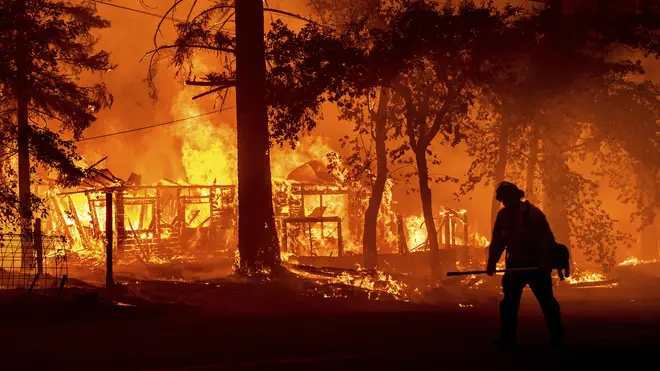
Nick Ferrari 7am - 10am
26 July 2021, 09:54

The Dixie Fire has charred almost 298 square miles in the Plumas and Butte counties.
California’s largest wildfire has destroyed homes in remote areas after merging with a smaller blaze, as numerous other fires gained strength and threatened property across the US west.
The massive Dixie Fire, which started on July 14, had already levelled more than a dozen houses and other structures when it combined with the Fly Fire and tore through the tiny Northern California community of Indian Falls.
Fire officials said the blaze had charred nearly 298 square miles of timber and brush in Plumas and Butte counties. It is now estimated to be 21% contained.
Firefighters carrying hand tools were forced to hike through rugged terrain where engines cannot reach, said Rick Carhart, spokesman for the California Department of Forestry and Fire Protection.

“It has been burning in extremely steep canyons, some places where it is almost impossible for human beings to set foot on the ground to get in there,” he said.
“It’s going to be a long haul.”
Crews made progress by proactively setting fires to rob the main blaze of fuels, Mr Carhart said.
The fire prompted evacuation orders in several small mountain communities and along the west shore of Lake Almanor, a popular resort area. About 10,000 homes remain under threat.
Firefighters also reported progress against the nation’s largest wildfire, the Bootleg Fire in southern Oregon, containing 46% of the blaze that had consumed nearly 640 square miles.
More than 2,200 firefighters battled the blaze, focusing on constructing containment lines at the north and eastern edges in dense timber.

Crews could get a break from rain and higher humidity predicted for this week, said Marcus Kauffman, spokesman for the Oregon Department of Forestry.
The fire, which is said to have been caused by lightning, has burned 67 homes, mainly cabins, and at least 2,000 houses were under evacuation orders.
Oregon governor Kate Brown told CNN’s State of the Union that it is imperative federal and state authorities invest in mitigation measures such as tree thinning and preventive burns to limit the number of similar massive blazes.
But she conceded that “the harsh reality is that we’re going to see more of these wildfires”.
In California, governor Gavin Newsom declared a state of emergency for four northern counties because of wildfires that he said were causing “conditions of extreme peril to the safety of persons and property”. The proclamation opened the way for more state support.

Such conditions are often from a combination of unusual random, short-term and natural weather patterns heightened by long-term, human-caused climate change.
Global warming has made the west much warmer and drier in the past 30 years.
In south-west Montana, officials were focusing on structure protection for three fires amid weather forecasts of rising temperatures, low humidity and westerly winds this week, factors that could produce explosive growth.
Crews were trying to protect about 200 homes and cabins and prevent the 44-square-mile Trail Creek blaze from reaching the Big Hole National Battlefield in Beaverhead County, fire spokesman Jason Nedlo said.
The battlefield site, operated by the National Park Service, has been closed because of the fire threat.
Five federal firefighters are in stable condition Sunday after being burned when swirling winds blew a wildfire back on them in eastern Montana on Thursday.

The five were building a defensive line at the Devil’s Creek Fire in Garfield County when the weather shifted suddenly.
Elsewhere in California, the 104-square-mile Tamarack fire south of Lake Tahoe continued to burn through timber and chaparral and threatened communities on both sides of the California-Nevada state line.
The fire, sparked by lightning July 4 in Alpine County, California has destroyed at least 23 buildings, including more than a dozen in Nevada. It was 27% contained on Sunday, and officials were able to lift evacuation orders.
In north-central Washington, firefighters battled two blazes in Okanogan County that threatened hundreds of homes and again caused hazardous air quality conditions on Saturday.
And in northern Idaho, east of Spokane, Washington, a small fire near the Silverwood Theme Park prompted evacuations on Friday evening at the park and in the surrounding area. The theme park was back open on Saturday with the fire half-contained.
More than 85 large wildfires are burning around the country, most of them in Western states. They had burned over 1.4 million acres (2,135 square miles, or more than 553,000 hectares).